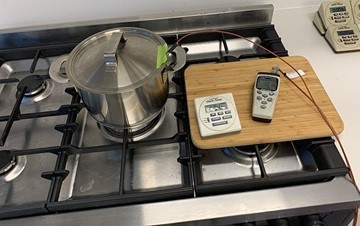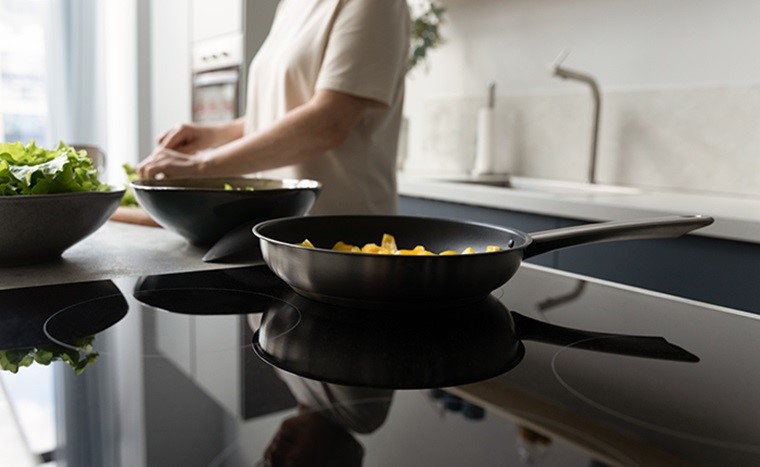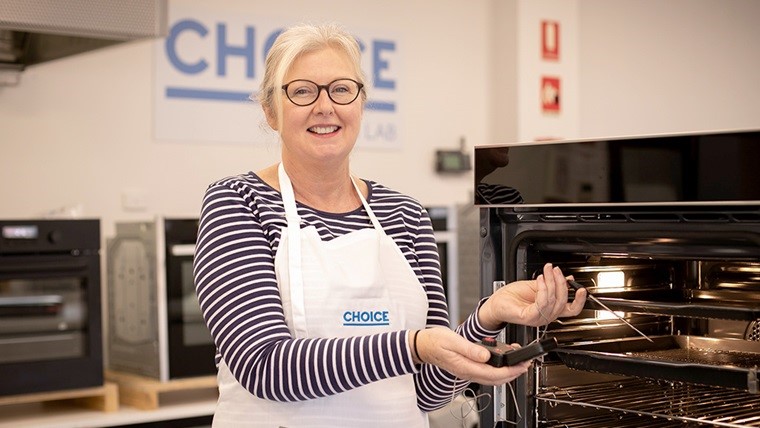Reposted from CHOICE with their permission.
Worried about the rising costs and health risks of cooking with gas? Here are some tips on the switch from gas to induction.


Need to know
- There are many benefits in switching from gas to induction cooking, including for cooking efficiency, ease of cleaning and health
- Portable induction cooktops can be a cheaper way to give induction cooking a try to see if it’s right for you
- CHOICE experts have reviewed a range of induction cooktops and portable induction cooktops. CHOICE members have exclusive access to our detailed reviews and ratings.
These days, choosing a cooking appliance means considering more than just price and convenience. There’s the impact on the environment, how much it costs to buy, run and maintain, and even how it might affect our health.
Warnings about the health implications of using gas in the home, particularly for children and people living with asthma, combined with soaring gas bills and a desire to minimise reliance on fossil fuels, have understandably led many households to investigate alternatives to gas cooktops and gas heating.
If you’re contemplating extinguishing the flame in favour of an induction cooktop, here are some things to consider when it comes to shifting from gas.
Gas vs induction – which is more efficient?
While many chefs and home cooks swear by their gas cooktop, the reality is that induction is superior when it comes to efficiency. This is because energy is directed into the cookware base instantly, transferring with approximately 85% efficiency. Comparatively, cooktops that transfer energy via gas-powered heating elements operate at an efficiency of 32%.
With induction, because the heat is coming from the cookware itself, rather than the cooktop, your cookware reaches the desired temperature more quickly, cooking your food faster.
To confirm which cooktop heats your pots most efficiently, CHOICE experts conducted a ‘boil time test’, measuring the time taken to boil one litre of water on different types of cooktops. The results placed induction first, followed by gas and then ceramic.
One of the top-performing models in our induction cooktop review takes just 2.37 minutes to bring a litre of water to the boil, while a gas cooktop can take four minutes or longer. (This will depend on the gas cooktop and the cookware you’re using).
“Because the heat is coming from the cookware itself, rather than the cooktop, your cookware reaches the desired temperature more quickly, cooking your food faster”
CHOICE kitchen expert Fiona Mair says that, like gas, induction responds instantly to temperature adjustments, although this is easier to see with a gas cooktop. “Gas provides visual feedback when you raise and lower the flame, but with induction you won’t see anything until you add food to the pan,” she says.
Although not everyone will be persuaded to give up the flicker of a gas flame, well-regarded chefs, such as Neil Perry and Shannon Bennett, are now so convinced of induction they’re making the change in their own commercial kitchens. “It’s much faster to cook with induction, which is a more efficient use of energy. Cutting energy use makes a huge difference in a commercial kitchen,” says Neil Perry in Good Food.
Trailblazing chef Analiese Gregory, who favours the use of a portable induction cooktop, says: “I’m all about creativity and innovation in the kitchen – and that means I’m all about induction. The transition away from gas is really important – I have a portable induction because it’s fast, it’s cheap and I can take it anywhere with me.”
The impact of gas on our health
There’s conclusive evidence that gas cooktops contribute significantly to poor respiratory health. Most concerning of all is the effect on children. “Gas cooktops contribute 12% of the childhood asthma burden, which is equivalent to tobacco smoke in the home,” says Asthma Australia CEO Michele Goldman.
It’s alarming to think that something as simple as frying an egg can have such a detrimental impact. While using any cooktop surface to cook your dinner can produce pollutants, such as the smoke you may see coming from the surface of a hot pan, Goldman explains that gas cooking is the most concerning, as the burning of gas produces additional pollution with the release of harmful gases and particulate matter.


“There are a range of contaminants released from a gas cooktop … like nitrogen dioxide, formaldehyde and small particulates that are breathed deeply into the airways and can cross into the bloodstream”
Asthma Australia CEO Michele Goldman
“There are a range of contaminants released from a gas cooktop that can impact your health,” explains Goldman. “Things like nitrogen dioxide, formaldehyde and small particulates that are breathed deeply into the airways and can cross into the bloodstream. So it’s not only the lungs that are impacted, it’s other organs.”
If you or a family member is living with asthma, she recommend that you always ventilate the kitchen with a rangehood, to keep doors and windows open and, if possible, to keep children out of the kitchen while cooking with gas.
Using an air purifier with a HEPA filter in the cooking area can also help alleviate pollutants. A 2014 study reported that air purifiers with HEPA and carbon filters can significantly decrease nitrogen dioxide concentration in the kitchen.
Read more: How to buy a great induction cooktop
Switching from gas to induction: which is better?
CHOICE experts consider efficiency, safety and ease of cleaning on different types of cooktops.
Is your cookware compatible with induction?
Induction cooktops work by producing an electromagnetic field, creating energy that heats your cookware. So your pots and pans need a ferromagnetic base to work on an induction cooktop.
“Cast iron, steel, and some enamel steel and stainless steel pans will work on induction if the base is a magnetic grade of stainless steel,” says Fiona.
But there’s bad news if you have all aluminium, glass or ceramic pans, as these are not suitable for use on induction cooktops.
Before you rush out to buy new cookware, Fiona suggests taking a magnet and checking the pots and pans in your kitchen. If the magnet sticks well to the base, your pan will work on an induction cooktop.


Gas vs induction: Which cooks better?
It may take a little while to become acquainted with an induction cooktop as you learn which size pan to use on which cooking zone and figure out how the child-lock and safety cut-out features work (these safety features are another advantage of choosing induction over gas). But, once you’re comfortable, you’ll find little to no difference in cooking results. If anything, you may discover dinner is ready quicker, due to induction’s increased efficiency.
The most important thing to remember when choosing an induction cooktop is to choose one with a range of cooking zone configurations. You should ensure the size of the base of your pans closely fits the designated cooking zones, so that the entire base is in direct contact with the induction zone. This is because it’s the pan itself that’s directly heated, and more contact means better heat transference. Using a pan with a smaller or larger diameter than the induction zone creates a weaker magnetic field and less heat output.
“Induction cooktops come in all sizes and have a range of cooking zone configurations,” says Fiona.
“Child-lock and safety cut-out features … are another advantage of choosing induction over gas”
“If you’re buying a new induction cooktop, choose one which has a variety of cooking zones in different sizes, such as an extra-large, flexi (an enlarged single zone that heats pans of any size that are positioned within it) and a small cooking zone, as these are better matched to a variety of cookware sizes.”
While some cooks might lament the lack of a dedicated wok burner that many gas cooktops have, you can purchase flat-bottomed induction woks to use on your induction cooktop that will easily reach the required heat intensity for a good stir-fry. Instead of tossing the food in the wok, you simply need to use a cooking implement to move the food around instead.
Induction is easier to clean
Anyone who has spent hours trying to clean those fiddly burners and trivets on a gas cooktop will find cleaning an induction cooktop a breeze. With their knob-free, continuous glass surface, induction cooktops are generally much easier to clean.
Fiona explains that even if you spill food onto an induction cooktop, it won’t bake on and become impossible to clean off (as often happens with gas and ceramic cooktops). This is because, with induction, the cooktop surface doesn’t heat up, so it’s much easier to wipe up a spill.
“On the downside, sugary substances can stick to the glass and create an uneven surface and you may have to buy a special cream to keep your cooktop streak-free and remove any marks from pans,” says Fiona. “Touch controls may also become unresponsive if they are greasy from cooking splatters.”
When testing cooktops, CHOICE experts always give each model an ‘Ease of use’ score which includes a note on how easy each model is to clean. Induction cooktops continually come out on top in this respect.
Portable induction cooktops may be a cheaper workaround
With fully installed induction cooktops ranging from $700 for a budget option up to $4000, a portable induction cooktop is a more economical way to dip your toe into gas-free cooking. They start at around $50, with top-performing models in our test costing little more than $100.
Portable induction cooktops are a great option if you’re renting or caravanning, if you’d like to reduce your reliance on gas, or if you’re keen to try induction before making a significant investment.
While they have their shortcomings, such as only one or two cooking zones, which will limit the size of the cookware you can use, portable induction cookers are much more affordable and don’t require installation (you just plug it in and turn it on).
“A portable induction cooktop is a more economical way to dip your toe into gas-free cooking”
The ongoing running costs of portable models are also comparable with a built-in cooktop. Typically, the yearly cost to run an induction cooktop hovers around $30–$60, regardless of whether it’s built-in or portable.
For example, one high-performing built-in induction cooktop we’ve tested has a retail price of just over $2000, and costs just $55 in running costs over the course of a year. For comparison, you can pick up a high-performing portable induction cooktop for just over $100 with running costs of $45 per year.
To find out more about portable induction cooktops, take a look at our portable induction cooktop buying guide and portable induction cooktop reviews.


Installation considerations
Not only can induction cooktops be expensive to buy, the installation costs can also be significant. You may also need to check if the power supplied to your home has adequate wattage to service the cooktop. While most induction cooktops are made to be compatible with the standard supply, Fiona says to check the power needs of the appliance you would like to buy, because if your home currently cannot accommodate the extra power needed, it can be extremely expensive.
“An home plug usually has a 10 Amp connection, whereas an induction cooktop may require a 20A, 32A or even 42A connection. These will have to be hard-wired by a licensed electrician if you don’t have an existing connection. You may also need an extra circuit to accommodate the higher wattage and this will add more costs,” she explains.
Will switching to induction save you money?
The benefits of an induction cooktop win out over gas in many areas. But will switching from gas to induction save you money in the long term?
“Running costs for induction are certainly cheaper than gas, but because the purchase price and installation costs are so high for induction, you’re unlikely to make dramatic savings immediately,” says CHOICE expert Chris Barnes.”You’re more likely to make significant savings when you switch away from gas for all your appliances – for cooking, heating and hot water. If you can also install a good solar power system and use it wisely, I would say that long-term savings are pretty much guaranteed.”
While we can’t perform a definitive cost analysis between gas and induction cooktops, the Climate Council has calculated that households can save between $500 and $1900 a year (depending on the price of gas in your area) by switching completely from gas and having the gas connection cut off. Ensuring you have your gas supply cut off is important as, even if you don’t use it, it may cost hundreds of dollars annually in supply charges.
“I don’t think we’ll ever again see the cheap gas prices of past decades that once made gas attractive”
CHOICE expert, Chris Barnes
It stands to reason that ditching gas is the prudent way forward for the cost-conscious, especially as gas prices are on an upwards trend due to several global factors.
“Gas price stabilisation is the best we can hope for,” says Barnes. “It’s more likely that gas prices will increase over time, and I don’t think we’ll ever again see the cheap gas prices of past decades that once made gas attractive.”
To find out more about induction cooktops and to find the right one for you, check out our induction cooktop buying guide.
Find out more at CHOICE here: https://www.choice.com.au/







